I got a query from someone who had visited this site after buying a pistol because it looked beautiful – which is the best possible reason. The pistol is missing its ramrod, and he asked for advice. This set me thinking about ramrods in general, and made me go and poke about in my cupboards and books to see if I could find anything useful…… click to read more!
The rod that is carried under or alongside the barrel in a gun or pistol is normally referred to as the ramrod – the term ‘loading rod’ usually refers to a separate wooden or plastic rod that is in one piece and carried separately. It will be stronger and a bit longer than the ramrod and have a more substantial button on the end that is pushed. The 3 piece rod usually supplied in gun cases it isn’t equipped with an end suitable for loading and is really an unloading and cleaning rod and is often supplied with a jag ( a brass fitting to hold a wrap of tow or rag or polyester fibre for cleaning) or a wool mop for oiling the barrel in breech loaders.
Almost all guns and pistols that might be used in the field or for defense had ramrods, and that probably goes for all flintlocks, but there were some types of firearm that did not usually have them fitted ;- percussion live pigeon guns and late percussion target pistols and special target rifles being examples – guns that were used in a single location where a loading table was part of the shooting setup, and in the case of target weapons, where the barrel might need to be swabbed between shots.
Late target pistol by Bales of Ipswich made without ramrods but with a loading/cleaning rod in the case.
Interchangeable covers for the extractor screw – a loading head or a jag for cleaning – from the case of Bales of Ipswich target pistols above
The form of the ramrod depended on the type and function of the gun – muzzle loading rifles needed a strong ramrod to force the patched bullet down the barrel – sometimes requiring a mallet to knock it down, and these would sometimes be steel, as in almost all military arms. Where a ramrod was intended to drive the bullet down the end was usually shaped to conform to the front of the bullet. Pistols and carbines intended for use on horseback normally had captive ramrods with a link mechanism at the muzzle and were of necessity steel.
Most sporting guns and and duelling pistols had wooden ramrods, as did many rifles, allbeit with stouter rods than shotguns. For long guns the wood used was often ebony or rosewood, both dark woods, but pistols do seem to have lighter coloured wood in some rods.
I’ve added this bit about unusual Wogdon ramrods for his duelling pistols from a later post ;-
One unusual feature of Wogdon’s duelling pistols was his ramrods. When he made a pair of duelling pistols (all pistols were normally sold in pairs) one had a plain ramrod with a horn tip, and the other had a powder measure/loading cup on one end and a ball pulling screw on the other’ . The meausure/loader was a substantial feature, although how useful it actually was, I don’t know, although I suspect not very! The purpose of the rod end was twofold – it provided a powder measure so that the charge loaded was always exactly right, and it allowed the loader to insert the powder right into the breech rather than pour it down the barrel from the muzzle (you hold the pistol muzzle down and insert the rod fully, then turn them muzzle up). This technique is common in competition muzzle loading rifle shooting as it keeps the powder from contamination and losses in the barrel, but I would question how important an exact charge is in a duelling pistol that is normally snap shot. It probably indicates that duelling pistols were used more often for target shooting in galleries than duelling. Anyway, I need one for my Wogdon recreation, so I thought I’d quickly make a tryout to workout how to do it. I figured that I could get away with a 6.1 mm hole in the measure, which let me use a 9/32 x 26 BSF thread. I should have screwed the two parts together before I tapered them, but I cut them separately, setting the top slide to about 1.5 degrees of taper, which I calculated would be right. Because of holding constraints I cut the tapers on the two parts in different directions , setting the adjustable top slide as near as I could in each direction. As it was a trial I didn’t spend a lot of time on the details – it was just to make something to check the ramrod pipes and groove before I got too far with the finishing. Having said that, it turned out much better than I deserved! I checked how much powder the measure holds – around 0.7 drams – probably a bit low, I would have guessed 1 dram as a good load…..but I was using shotgun powder, not the fine pistol powder so that might account for the difference, or at least some of it.
This is my Wogdon recreation part finished.
Reversed for loadng
End of inserted bit…………………………………………………
It is, of course, very difficult, if not impossible, to determine if a particular rod is as old as the gun it is with, or when it might have been replaced. Wooden rods are probably the part of the gun most likely to be broken of lost, so a good proportion of rods may well be contemporary replacements, not to mention recent replacements.
Wooden rods had either brass or horn tips, or sometimes in pistols were just the wooden end of the rod. Brass tips were in two forms – with a through hole that slipped over a turned down portion of the rod and was held in place by a small wedge or a brass pin, or as a cap over the end of the ramrod usually pinned with a brass pin. Rifles normally had the cap type tip because it had to be more or less shaped to the nose of the bullet or to the ball, and needed to be stronger. Horn tips were always of the cap type, and were fixed without visible pins. The tips fell into two rough shape catagories – the trumpet shape and the tulip shape – I’m not sure if there is any correlation between date and shape although a lot of pistols and guns around the last quarter of the 18th century had slightly tulip shaped tips.
The other end of the rod of a long gun usually terminated in a brass fitting that housed a tapered screw thread of a particularly deep, square thread form under a screw off brass cap. The screw was to unload the gun in case of a misfire or a wrong loading – i.e. forgetting to put any powder in (we have all been there).
Blair and Sutherland ramrod tip – horn
Ramrod screws almost always had a deep, square cut thread – woodscrews won’t do!
Pairs of pistols (especially cased pairs) often had a different inner end to each rod – one would be plain, and the other would have a screw or a small worm
Ramrods and one of a pair of Edwards of Dublin Duelling pistols – late C18 – the bottom rod has a plain rounded ‘inner’ end
Ramrods are generally quite thin, and because they need to be accommodated under the barrel, are rarely much longer than the barrel, meaning that typically when the rod is dropped in the barrel without a load, only a centimeter or so protrudes making it difficult to get hold of the rod if you need to extract a charge. For these reasons modern shooters of muzzle loaders in ‘static’ shooting situations almost never use the gun’s ramrod, preferring to carry a stout plastic rod for loading and a sectional cleaning rod with an extractor screw for unloading. For walk-up shooting and shooting ‘on the fly’ you might want to make a holster on your belt to carry the loading rod.
Apart from their use in loading and removing charges, ramrods are part of the balance of a shotgun, and for that reason it is always better to leave one in place, even if you don’t intend to use it. Because so many ramrods are replacements, its not uncommon to discover that they don’t fit particularly well, and as many barrels have at some time in their lives had a bit taken off the end of the barrel to ‘tidy it up’ or to go with the fashion for shorter barrels, the lip on the bottom rib that should hold the rod in has not been replaced – so there are guns where the ramrod jumps forward on firing, and if you don’t remember to push it back in may get pulled out by the blast. In this case put a bit of tape – ideally self vulcanising tape – round the rod in the position of the pipe nearest the muzzle and jam it in.
Loading rods used in driven game shooting are often carried in a tube with a pointed end that can be pushed into the ground – the rod is then handy to pick up and put down and doesn’t get dirty and wet – it needs a funnel shape at the top to speed up putting it back! For clay shooting people have a variety of ingenious ways of coping with the loading rods – from modified golf trolleys to modified camera tripods, although most of us just carry the rod and leave it on the loading table or stand it on the ground somewhere! If you use a loading rod its a good safety idea to put a piece of tape round the rod to indicate how far it goes into the barrel when there is no charge in the gun – that way you can quickly check that its properly loaded, and also check easily for the very dangerous double charge in one barrel – one of the hazards of shooting muzzle loading doubles.
Pistol stocks sometimes have a spring secreted within the stock or the rear pipe that is supposed to retain the ramrod.
Medium sized old cleaning rods for most guns in the UK used 9/32 B.S.F. 26 t.p.i. threads for the brushes and jaggs etc at the business end – I’m not sure if they still do ? Sectional rods use a variety of different threads to connect them.
.I have now made some unloading worms that have 9/32 x 26 (9/32 BSF) threads that can be screwed into tapped holes int eh end of loading rods, thus turning your loading rod into an unloading rod – you then don’t need to take a separate rod with you (usually a 3 piece rod) in case you have to unload.
Making a ramrod for a sporting gun;
I needed a ramrod for the 11 bore Westley Richards – its a ‘working gun’ so it doesn’t need to be fantastic, so I spared the ebony and used a 10 m.m. ash dowel I bought at a re-enactment fair as an arrow blank – I selected all his straight ones! I wrapped masking tape round one end so it fitted in the chuck of my Vicmark woodturning lathe – the other end just rested inside the hollow tailstock. Using 80 grade sandpaper I tapered the rod to 8.5 m.m at the end, and smoothed it down. I have had problems staining the wood to match ebony – the ash is not very absorbant and its difficult to get a deep enough colour – I did think of ‘ebonising’ it with a blowtorch but wasn’t sure if it would work. In the end I got a black felt pen of the sort that marks on everything and ran it down the rod while the lathe turned slowly so as to cover the entire surface – result a fantastic deep black – a couple of coats of water based satin varnish rubbed in with a tissue and its a very convincing ebony rod! I decided to make a proper screw end as they are sometimes handy if I forget my unloading rod. I has a 1/4 x 32 tap and die (Model Engineer threads) for the cap thread, and cut off a 5 m.m. hardened zinc plated screw – getting rid of enough of the tread to solder into the brass body was done by putting the screw point first in a drill and running it against the grindwheel. A 5.4 mm hole up the cap end cleared the screw and was right for tapping the 1/4 x 32 thread. The head was turned freehand – not perfect but OK – result a perfectly acceptable substitute for the real thing – NOT a fake – you can tell because I Araldited the ends on and didn’t put ‘fake’ pins through! Note for future efforts – be more careful to size the rod and ends to the same diameter and make sure the reduced diameter on teh rod is concentric.
The zinc plated screw was blacked with TIFOO instant gun black.
It really should be lemon coloured brass, but it will still work!
I think I soldered the screw in slightly crooked so its pushing the cap out of true – I’ll fix it sometime! (or just get used to it). The brass has been toned down a bit with dilute Blackley’s brass browning solution.
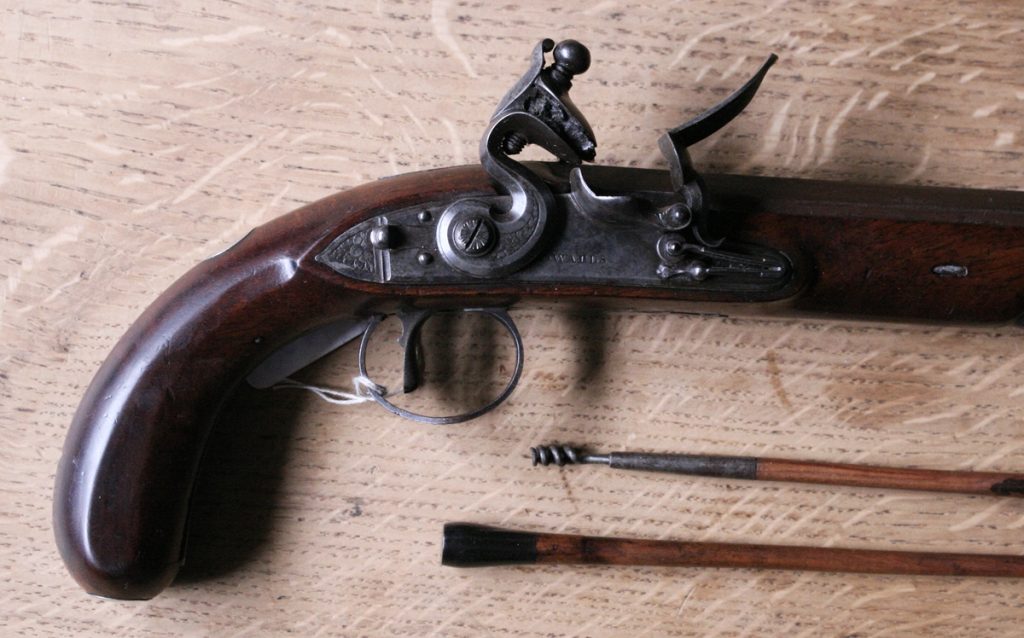
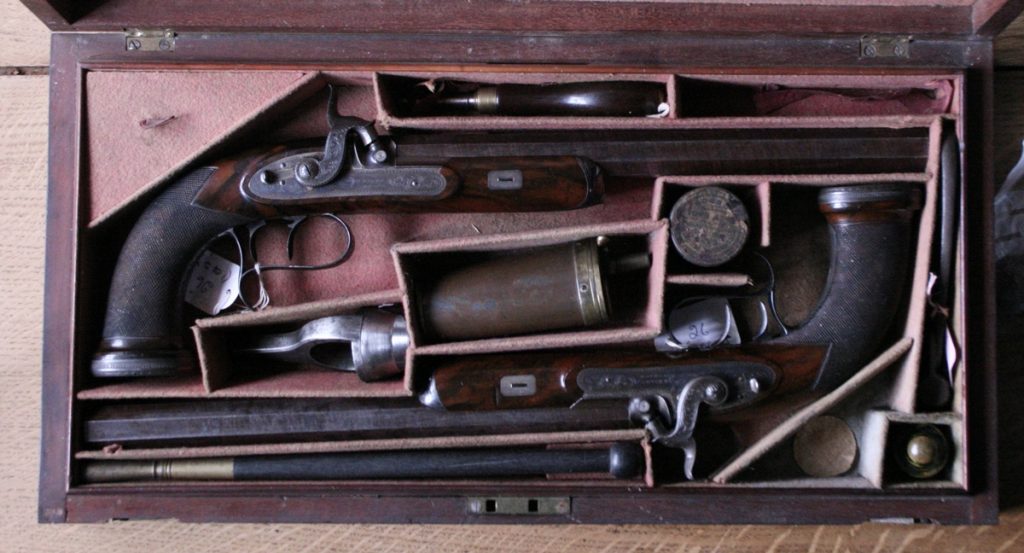
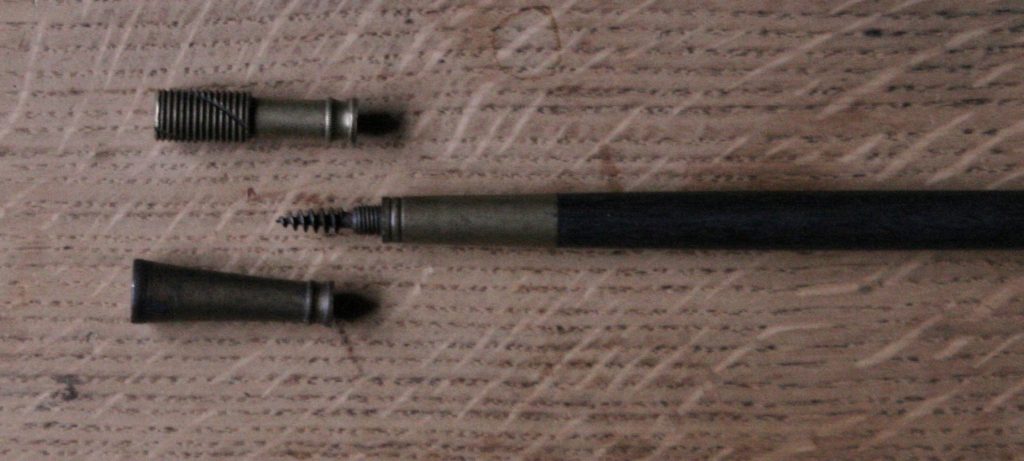
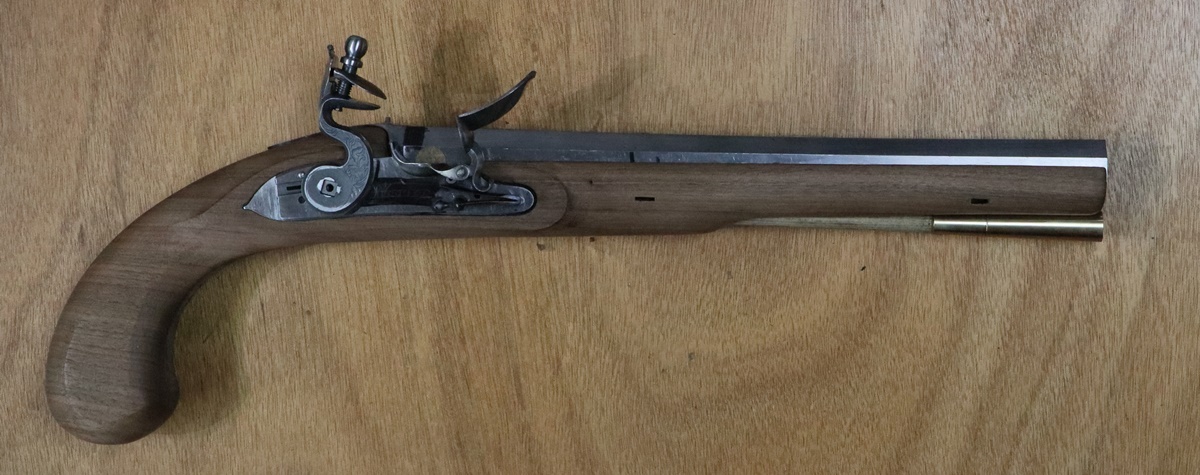




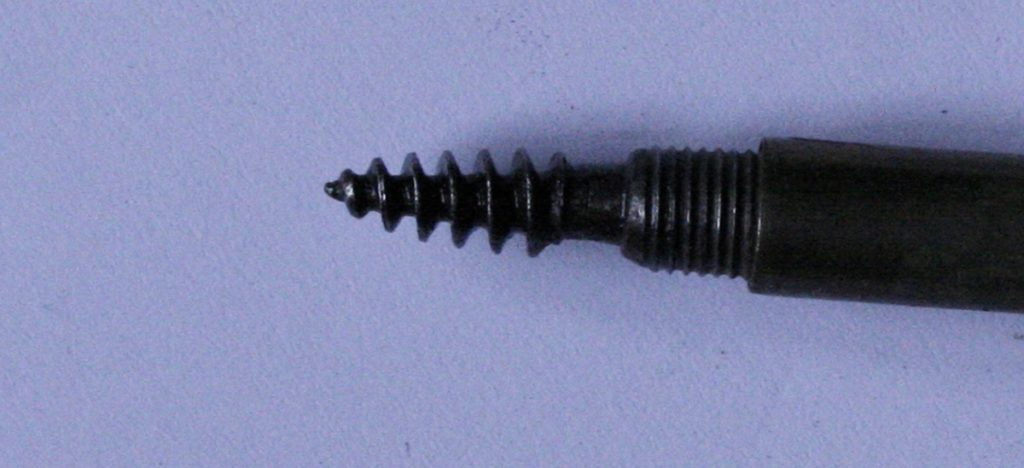

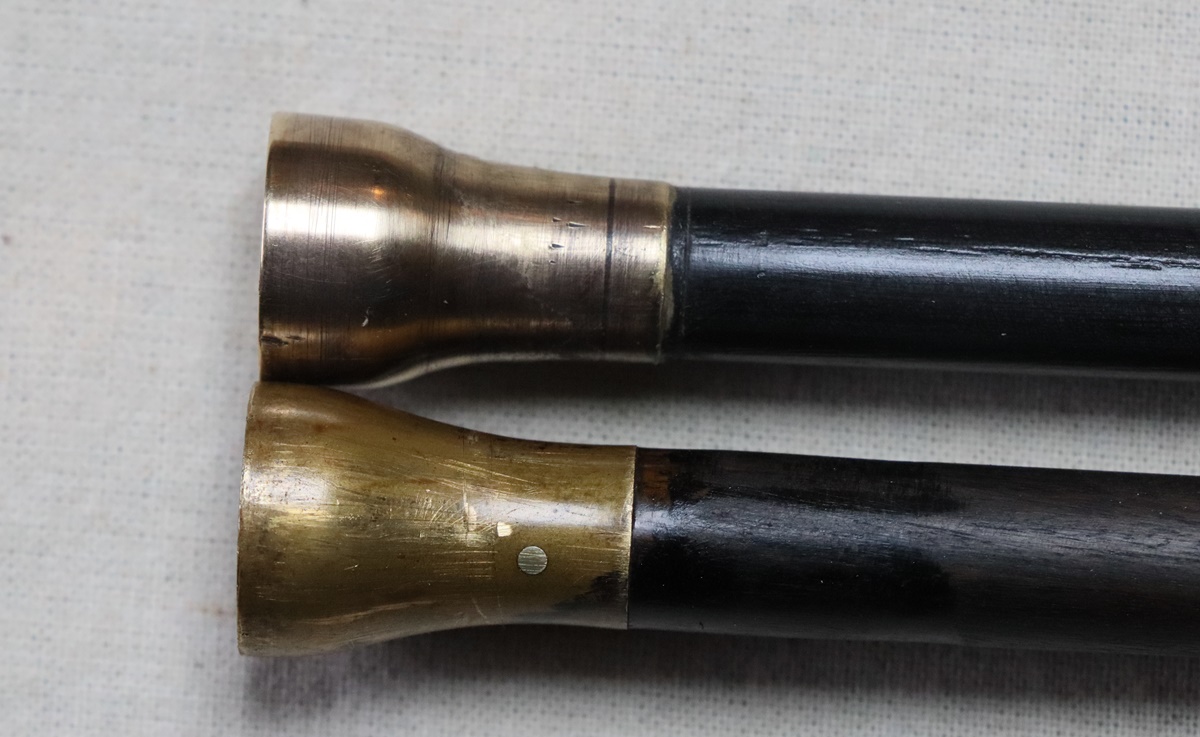
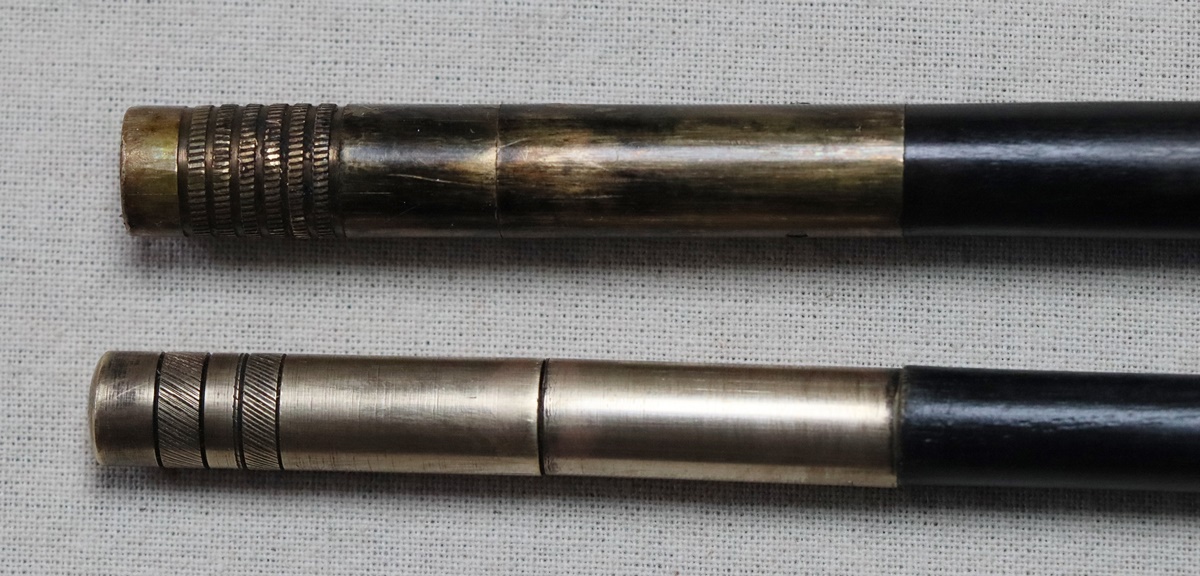
Hello Tim,
I have an Elliot’s Pattern 1759 Dragoon pistol in good condition that is missing the ramrod. Can you make one that would look old, to fit the character of the pistol? I am in USA.
Thank you,
George
HI George,
I don’t have any illustrations of the 1759 Eliot pistols, but at that date I assume they would have had a wooden ramrod with brass ferule on the breech end – not sure about the muzzle end, porobably plain wiood.
I can make those, but would need some dimensions to work from – ie diameters at all the pipes, and lengths to pipes etc to reasonable accuracy, plus photos.
I guess I can ship to the US – not sure of the cost. Cost of the ramrod would be GBP 100.00
Regatds
Tim
Antique folding ramrod I’m a dealer in antiques and had a folding steel ramrod opened up it is 28 inches in length, looks like it was made by blacksmith wondering whether you had come across this before.
Hi Mike,
No, I haven’t – I wonder why someone would want one, maybe their gun had lost the ramrod pipes so couldn’t use the normal one. I would have thought that the joint might allow the rod to bend and potentially scratch the inside of the barrel?
interesting – I’ll add that to my mental store of oddities.
Thanks
Tim
Do you make wooden ramrod replacements for French flintlock pistols?
Yes, I can normally do that but I don’t have a pattern so I’d have to find some good photos. At the moment I am not taking on any new work for a couple of months as I am busy being a builder!
Sorry, Tim
Dear sir i have an replica flint lock pistol with the ramming rod missing is there any way i could find a design and make one
Hi Martin,
Send me a photo of the pistol and I may be able to help, otherwise just look at a lot of photos of pistols on google images.
Tim
I have a double barrel percussion pistol, with the ramrod missing. Do you know where I might be able to get one, or have one made?
thanks, Roger
That is something we can do, send me a photo – my email is on contact page
Hi Tim
Would love some advice on making a shotgun tapered ramrod.
Wood is usually supplied straight in square section length.
I think turning a taper on a lathe would not be easy?
Regards
Chris
Hi Chris,
Yes, turning one is tricky, although I have done it, you need a hollow tailstock and headstock and a 4 jaw chuck and make a holder for the tailstock and turn it in 6 inch sections.
It is probably easier to plane it tapered square, then cut 45 degree bevels on a couple of pieces of wood and fix them together so you can hold the square to plane off the corners to get a octagonal rod, then plane off the angles and finish in the lathe with hand held sandpaper. I prefer the second method – I do have a nice piece of ebony – enough for half a dozen rods- it cost about £100 – and I’ve got to make a few rods when I get the flat finished, maybe I’ll write it up.
Thanks for your interest.
Tim
Hi Tim,
Interesting article just wondering if anyone could give me some info on a pistol ramrod I have?
Hi Dean,
Sure, send me details/photo and as much info as possible.
I’ll email you with my email so you can send it directly.
Tim